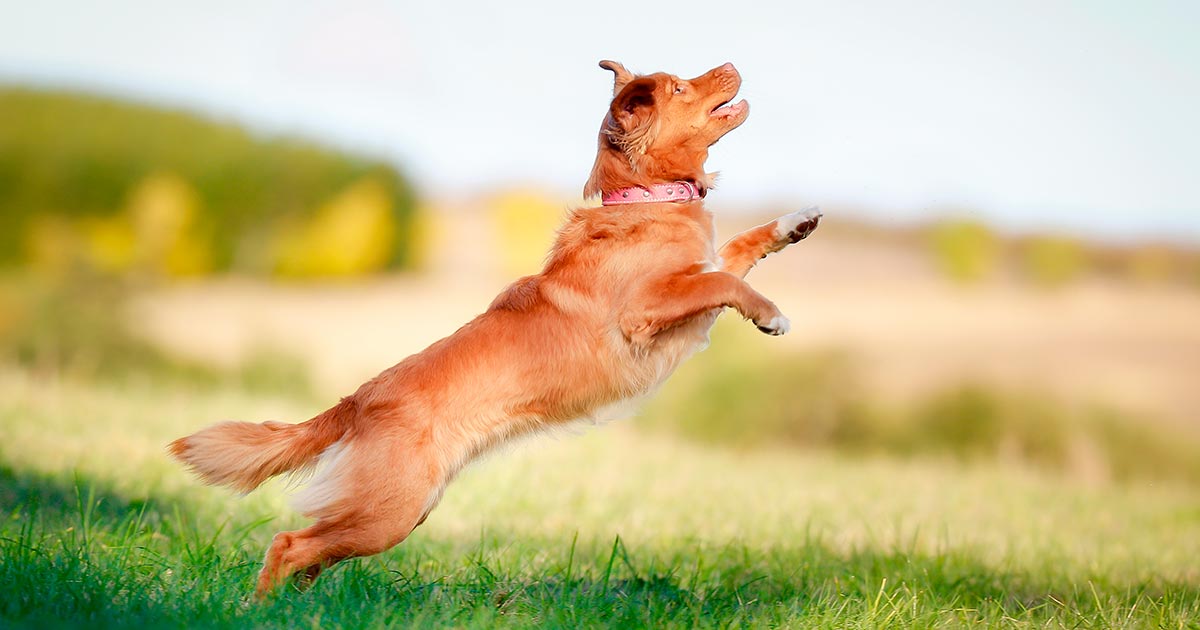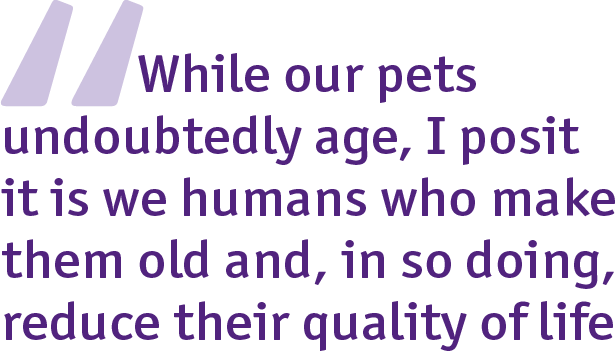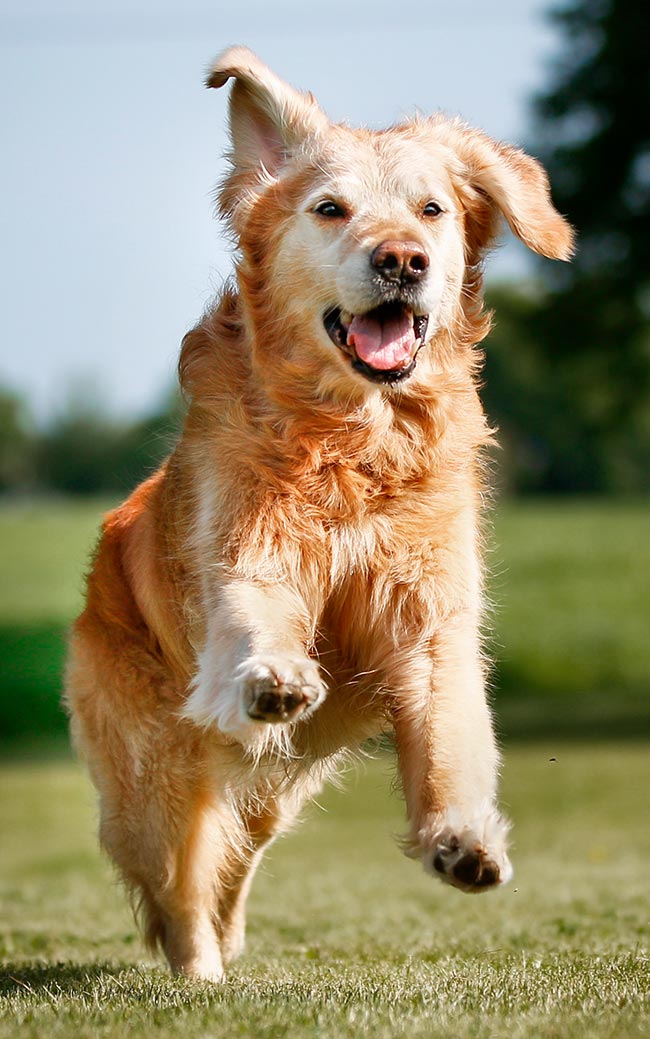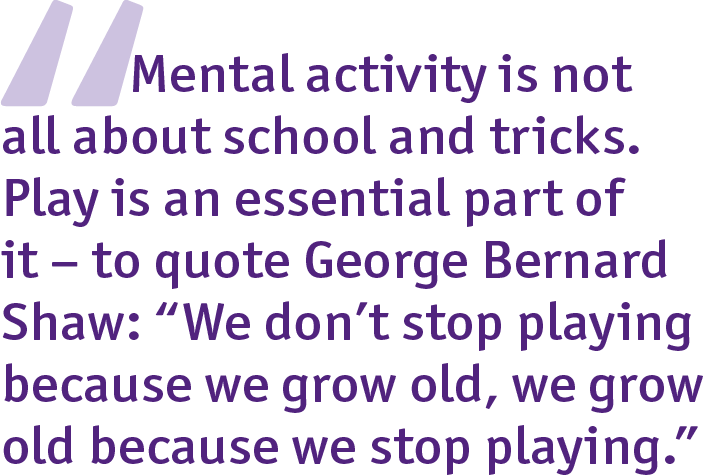7 Nov 2019
Lifelong welfare – teaching older animals new tricks

Image © Mikkel Bigandt / Adobe Stock
I wonder how you would answer baseball player Satchel Paige’s question: “How old would you be if you didn’t know how old you are?”
After all, age is simply a number.
I am in my seventh decade (older than 60 to the non-mathematicians), but feel 21 and a bit years old. Yes, the bit is getting bigger, but I still find the world a place full of wonder, fun and learning opportunities.
It may be the joys of life have changed – a 10-mile woodland walk opposed to a 25-mile mountain hike, while a late night is likely to be around midnight nowadays. However, I continue to find the world an adventure playground and have little intention of growing old, although my body continues to age – and this is the point of my article.
While our pets undoubtedly age, I posit it is we humans who make them old and, in so doing, reduce their quality of life.

Ageing
Ageing affects humans and non-humans, and is a natural process of deterioration, called senescence. It causes biological, psychological and social changes (Phillips et al, 2010; Krebs et al, 2018).
We can do much to prepare animals and owners for this normal aspect of life. This article is intended to start readers thinking about how to facilitate improvement in the quality of life for our ageing pets and, thus, for our ageing selves.
Biological ageing includes – but is not limited to – specific issues, such as:
- reduced kidney, liver and cardiac function
- increased susceptibility to infections
- fragility
- loss of muscle mass
- dental disease
- arthritis
Individuals may also have partial or total loss of sight, hearing or smell, and be less able to thermoregulate, for example, because of a thinning coat of fur.
Psychologically, ageing means some changes in mental abilities and personality. Think grumpy old man or woman, and jokes of “being an adult is just walking around wondering what you’re forgetting”.
Pets will also have mild changes in attention and memory (Kirova et al, 2015) – for example, they are likely to be less tolerant, and still want to play and walk, but not so fast or for so long. These are normal symptoms of ageing.
Of course, pathological forms of psychological ageing exist in humans and non-humans, such as cognitive dysfunction and Alzheimer’s disease/dementia, but these are not the subject of this article.
It should be remembered none of this is necessarily related to actual age. Biological and psychological symptoms associated with “old age” can happen at any time. The young and middle-aged can suffer from pain, exercise intolerance, sight and hearing loss, other medical problems, and cognitive decline and dysfunction, as in early onset dementia (Ritchie and Lovestone, 2002). Indeed, many animals are born with inherited conditions that mean they develop “old age” biological symptoms when they, really, should be in their prime.
The biological and psychological aspects of ageing both influence – and are influenced by – the individual’s social environment. Behaviour changes, such as decreased tolerance and increased aggressive responses, will alter how others respond to the ageing individual. Likewise, the individual’s resource-holding potential decreases as they become more frail, less mobile or suffer sensory loss. This affects not only one-to-one, dyadic interactions, but can have a ripple effect across the social structure of the whole group (Jones-Baade and McBride, 1999; Hurd, 2006).
Where the group involves humans, as for all our pets, the social effects of ageing may have more serious implications for the individual. Being old is considered by many to be an undesirable state in our present human society. Indeed, we tend to hide away our older citizens in “homes”, and do all we can to make ourselves appear younger and delay the inevitable senescence of our bodies; to the advertisers’ glee.
For a not insignificant number of animals, similar negative perceptions can have distressing consequences. Consider the numbers of “senior” animals, especially dogs and cats, that spend the final part of their lives in rehoming centres, perhaps relinquished for a younger model and, likewise, overlooked by potential adopters. Many will be euthanised simply because they are “too old” to home (Salaman et al, 1998; Scarlett et al, 2002).
Of course, for the majority of older pets, consequences are less dramatic, but still negative. Owners may spend less time interacting with them, or less quality time (from the animal’s perspective) by excluding them from previous activities because they are considered too old. The effect on the animal may be to instil a state of low mood – basically depression – characterised by symptoms of anhedonia (loss of interest in activities previously found pleasurable), insomnia or hypersomnia, and gaining or losing weight (Moreau, 2002).
Yet, by understanding ageing and changing owner perceptions, we can keep animals “young”, improve the human-animal relationship and, therefore, the welfare of all. Consequently, we can and should think ahead.
As with ourselves, we need to prepare for an old age life stage, whenever it happens. It should be a life stage that is not only as physically comfortable as possible, but also psychologically enjoyable.
A really important part of this is to not allow numbers to dictate how we view our pets. Being a “senior” is not being old, just a little more mature – remember, medical and veterinary advances are prolonging lifespans. Society is starting to accommodate the effect of these advances in the way we think about ourselves. For human “seniors”, 60 is the new 40 (or, in my case, 21 and a bigger bit). Let us ensure we sensibly apply the same principle to the later life of our animals.
Early preparations
Preparations for later life start at the beginning of life. I will not dwell on breed conformation and other inherited conditions, directly or indirectly selected for, that can lead to early-onset, old-age symptoms. However, we need to be absolutely clear that we have a choice (Companion Animal Welfare Council, 2006).
Ethically, we should be promoting breeding and conformations that do not clearly lead to early-onset old age, regardless of species. Think not just brachycephalia, but also issues such as excess skin, sloping backs, dwarfism and gigantism. Such welfare concerns affect billions of animals that we keep – be they dogs, cats, pygmy goats, dwarf and lop rabbits, miniature ponies, Arab horses, and reptiles and fish that are highly selected for unnatural colourations or conformations.
 Examples include the celestial eye goldfish, whose abnormal development means the eyes move to the top of the head and the individual becomes progressively blind over the first few months of its life; or the lionhead goldfish, whose abnormality affects its breathing and vision. No doubt these are both stressful and life-shortening conditions for a fish species that can live 15 years or more, and can be taught tricks.
Examples include the celestial eye goldfish, whose abnormal development means the eyes move to the top of the head and the individual becomes progressively blind over the first few months of its life; or the lionhead goldfish, whose abnormality affects its breathing and vision. No doubt these are both stressful and life-shortening conditions for a fish species that can live 15 years or more, and can be taught tricks.
We can advise existing and potential owners to research before buying additional pets – for example, by showing them the Genetic Welfare Problems of Companion Animals resource for prospective pet owners, from the Universities Federation for Animal Welfare.
We also need to encourage owners to obtain pets – including small mammals – directly from breeders, wherever possible. To get the message across, we need to explain why.
Environmental stressors that occur either prenatally and/or during early development – including during adolescence – have lifelong effects on neurobiology and health (Mayer and Saper, 2000; Burstein and Doron, 2018). Even short-term exposure to what we may perceive as mild adverse stressors has effects on adult health in rats, in terms of stress responses and eating disorders (Kalinchev et al, 2002). How much more may be the effects of being transported to a pet shop, or, in the case of many dogs and exotics, to a different country?
Further preparations relate to ensuring pets are kept fit physically and psychologically. This, of course, means appropriate nutrition and exercise. However, the latter for dogs is frequently limited by behaviour issues. These may relate to lack of appropriate socialisation, exposure to different environments and training. All must be continued to adulthood – until approximately 18 to 24 months of age if the dog is truly going to be well socialised, trained, and a confident, relaxed individual. Simply attending puppy classes is not going to be sufficient.
Many dogs are restricted to on-lead exercise for reasons that are avoidable. Dogs are evermore frequently exercised on extending leads, which can cause chronic or acute physical damage – watch how dogs walk on these leads, leaning and pulling to one side; how they are frequently jerked or reeled in by owners, rather than spoken to when changing direction or wanting the dog to come back to their side; or how dogs leap around on these leads when interacting with another dog. The latter is risky to both dogs – a quick trip could result in a torn cruciate ligament.
Many dogs are not let off lead because their owners have not been taught the basics of a reliable recall and obedience – namely, how to form a good relationship based on one-to-one interaction, beyond the use of food. Disturbingly, I frequently hear owners saying their dog is too young to be let off lead, when it is six or seven months old. Regrettably, the dog is not learning about recall, how to interact with other dogs, nor how to be confident by having opportunities when on a walk of exploring the world (Dienstbier, 1989; Grippo et al, 2014). All of this can have serious repercussions.
Apart from the physical issues relating to lack of exercise – and the tensions from pulling on leads – many of these dogs will be more anxious, and less resilient and able to cope with any future changes in their world, such as new family members or moving home, or visiting the veterinary surgery.
Likewise, lack of environmental enrichment and novelty in the cages of small mammals, and other taxa, will lead to frustration, boredom, lowered confidence, increased anxiety and depression (Grippo et al, 2014, McBride, 2017a; 2017b). Anxiety has negative long-term consequences for physical health and, therefore, later life stages (Dienstbier, 1989; Mayer and Saper, 2000; McBride, 2017a).
Therefore – in the case of dogs and equids – we should be directing owners to good trainers who will teach them and their pet life skills, using methods that instil confidence and obedience in the animal. This means trainers need to have a clear understanding of human-animal interactions and learning, positive reinforcement training and, thus, how to use methods that are least invasive and minimally aversive (McBride and Montgomery, 2018) – as is the ethical stance of those listed by The Animal Behaviour and Training Council.
This includes getting puppies off lead for exercise, teaching loose lead walking from the get-go, and teaching owners how to play with and how to teach their animals new behaviours (tricks), so they can continue to do so throughout their pet’s life.
This is important not just for dogs, but for all species – be it horses, parrots, cats, tortoises or goldfish, all of which can be taught using the principles of clicker training (R2 Fish School, 2009).

Mental activity
Lifelong learning and mental activity is the best preventive medicine against old age, regardless of physical health state. Old animals can learn new “tricks”, and doing so engages both animal and owner.
While most books are written for dogs (for example, Arrowsmith, 2010), most “brain games” can be taught to other species as the training principles are the same. Tricks may be formal, such as recall or walking nicely, or non-formal. “Tricks” are simply behaviours taught to a cue – from the animal’s perspective, sitting on cue is as much a trick as raising a paw on the phrase “shake hands”.
My last dog was learning new tricks until the end of his life, aged 16; my current 13-year-old will hopefully have time to learn several more – he is certainly keen to.
Of course, these tricks must be animal-ability appropriate. For example, learning to identify a new object, or giving three barks (or hoof taps) on one signal and two barks/taps to another, as opposed to teaching a senior dog to beg by sitting up on hindlegs. That would be like asking me to take up freerunning – not at this stage of my life.
However, mental activity is not all about school and tricks. Play is an essential part of it – to quote George Bernard Shaw: “We don’t stop playing because we grow old, we grow old because we stop playing.”
You may have heard owners who get a young dog say how their older dog has been rejuvenated. Why? Probably because the new dog never considered the original resident as old, but as another dog that may like to play. Ask the owners, and you will probably find they stopped playing with their dog months, if not years, before. Many will not have bought it a new toy in ages. They also probably do not give it much opportunity to play on its own. The games may change, but games should still be played right to the end of its life.
Although walks or rides and play sessions may not be as long, they should still be enjoyable and interesting. As an aside, that also means reminding owners of dogs with old-age symptoms to walk slower – not drag it along on a lead; or have it puffing and panting as it tries to keep up, with no time to investigate an interesting smell or say hello to passers-by.
What about the dog that had a job, such as the retired assistance dog, or the one that did tracking, retrieving or agility? What about the horse that used to jump?
Though I have never sent my dogs over A-frames (my concerns for damage to forelegs), my 13-year-old mongrel still does agility moves at home – with weave poles spaced wider and jumps smaller.
What about games of retrieve? If a dog does not like to fetch the balls or dummy it always had, could it be these are now too hard on its teeth, or too heavy? So, how about a different object?
Owners may still be using a ball thrower, but the dog simply may not be motivated to move that far, or has reduced sight and cannot see where the ball has gone – so abandon the plastic thrower, but not the game. Throw the ball not so far, or even roll it.
These simple principles of adapting mental activities are applicable to all animals.
Tracking (scentwork) can be a lifelong activity for dogs and owners. It is something all breeds, crossbreeds, designer breeds and mongrels can do. It has lots of additional advantages of teaching dogs concentration and is a useful remedial tool for those that are anxious.
I would like to see all owners learning how to encourage their dogs to use their noses in a controlled way (not scavenging). For animals with old-age symptoms, this is a perfect mental exercise with associated age-appropriate physical exercise – the dog will move at its own pace. If scenting ability reduces, use a stronger track; if free-tracking, use a smellier object to find.
 Free-tracking is a simple activity. My dog free-tracks almost every day. On walks, I may hide a toy and ask him to find it, or I hide myself and he has to come back from his sniffing wanderings to find me. At home and in the garden, he is sent to search either for a hidden toy, or part of his normal daily diet or for a treat, such as a single small cocktail sausage (a good source of scent) that I have scattered and hidden.
Free-tracking is a simple activity. My dog free-tracks almost every day. On walks, I may hide a toy and ask him to find it, or I hide myself and he has to come back from his sniffing wanderings to find me. At home and in the garden, he is sent to search either for a hidden toy, or part of his normal daily diet or for a treat, such as a single small cocktail sausage (a good source of scent) that I have scattered and hidden.
Cut the cocktail sausage in quarters lengthways and each quarter into four = 16 treats per sausage – suitable for even large breeds. These are mind-occupying and time-wasting games.
Another activity is puzzle toys – both commercial toys and cardboard boxes containing small bits of daily food or a treat, or a favourite toy that dog and owner can then play with together. The task of getting to the goodies can be made harder by placing boxes in boxes, like in Pass the Parcel. Boxes are incredibly easy to come by – including boxes the owner’s or dog’s medication has been packaged in, cereal packets, egg boxes, the box from the latest online purchase, and a crumpled-up cardboard tube from a toilet or kitchen roll. These are also great for rodents, parrots and cats. Additionally, owners have not only the pleasure of watching their pet have fun, but also the mental stimulation of finding and picking up the bits of torn cardboard – a different mindfulness exercise.
Conclusion
Owners have a responsibility for their animals for the whole of their lives, regardless of whether they are kept as pets, working animals, livestock or in the laboratory or zoo (Ziegler, 2019). They are totally dependent on us to provide for their welfare and give them a life worth living.
Having a life worth living depends on the animal experiencing positive emotions – for example, pleasure, confidence, interest and a sense of control over its environment, with opportunities to explore, solve problems, and gain sufficient physical and mental rest (Mellor, 2016).
Living well is for life, not just for the young and middle-aged.
I hope this article will motivate readers to work with owners of all species to help their animals live a life worth living for as long as they live.
